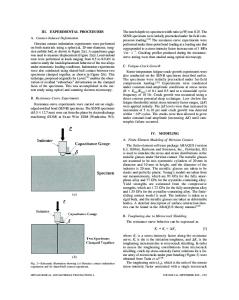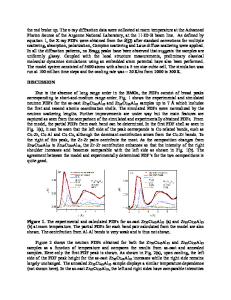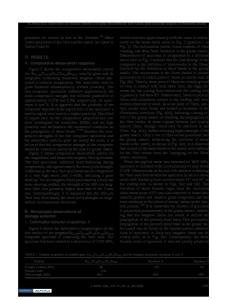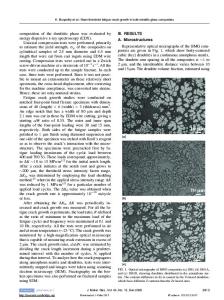Indentation behavior of a ZCAP-3 bulk metallic glass: Effects of the fatigue deformation
- PDF / 1,401,521 Bytes
- 7 Pages / 584.957 x 782.986 pts Page_size
- 31 Downloads / 352 Views
Gongyao Wang Department of Materials Science and Engineering, University of Tennessee, Knoxville, Tennessee 37994
Yoshihiko Yokoyama Advanced Research Center of Metallic Glasses, Institute for Materials Research, Tohoku University, Sendai 980-8577, Japan
Peter K. Liaw Department of Materials Science and Engineering, University of Tennessee, Knoxville, Tennessee 37994 (Received 25 November 2008; accepted 23 March 2009)
The effects of the fatigue deformation on the localized deformation of a ZCAP-3 bulk metallic glass (BMG) were studied using the nanoindentation technique. A localized mechanical hardening was observed in the ZCAP-3 BMG between the shear bands in the fatigue-damaged zone. In contrast to the indentations of the BMG made far away from the fatigue-damaged zone, there was no indentation size effect. Both the reduced contact modulus and the indentation hardness were larger than those corresponding to the indentations of the ZCAP-3 BMG in the undamaged zone. These observations revealed the possible effects of local heating and stress-induced atomic rearrangements (i.e., inelastic deformation) on the reduction of the free volume in the BMG from the propagation of the fatigue crack.
I. INTRODUCTION
The recent progress in making bulk metallic glasses (BMGs) has stimulated substantial interest in understanding mechanical behavior of BMGs due to their unique mechanical properties, such as the superior strength and hardness,1,2 good fracture toughness,3 and high wear resistance.4 Several techniques, including uniaxial, shear, and indentation tests, have been used to examine the mechanical behavior of various BMGs; the occurrence of serrated flow and the formation of shear bands during plastic deformation have been reported in numerous works. The understanding of the mechanical behavior of BMGs has been accelerated with the use of the nanoindentation technique, in which both the indentation hardness and the reduced contact modulus can be studied from the indentation loading–unloading curves. There are a few papers addressing the indentation behavior of deformed BMGs. Bei et al.5 performed nanoindentations of compressed Zr52.5Cu17.9Ni14.6Al10Ti5 BMGs and observed the decrease in the indentation hardness. Yoo and Jang6 used the nanoindentation technique to investigate a)
Address all correspondence to this author. e-mail: [email protected] DOI: 10.1557/JMR.2009.0270
2346
http://journals.cambridge.org
J. Mater. Res., Vol. 24, No. 7, Jul 2009 Downloaded: 03 Apr 2015
the subsurface deformation of a Zr52.5Cu17.9Ni14.6Al10Ti5 BMG after polishing the deformed BMG and observed variation of the indentation hardness in the deformation zone. However, it is unclear whether the shear bands or the BMG between shear bands solely contribute to the decrease of the indentation hardness; there is little study focusing on the indentation behavior of the BMG between shear bands in the deformation zone. The understanding of the indentation deformation of plastically deformed BMGs is still in its infancy in contrast to the ind
Data Loading...











